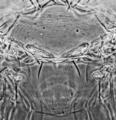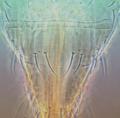Ankothrips gracilis
Recognition data
Distinguishing features
Female fully winged. Body and legs largely yellow; antennal segments IV–IX light brown, I–III paler with apex shaded; fore wings clear. Antennae 9-segmented, IX longer than VIII, sensoria transverse on III–IV, segment II apex prolonged ventro-laterally into small serrate lobe. Head with ocellar setae I arising on slightly bifurcate tubercle, setae III arise just within ocellar triangle. Head with one pair of long postocular setae and two shorter pairs. Pronotum trasversely striate, posterior margin with 7–8 pairs of prominent setae, one posteroangular pair at least three times as long as discal setae. Mesonotum closely transversely striate, with no microtrichia on sculpture lines. Metanotum closely longitudinally striate, with no microtrichia, median setae near posterior margin. Abdominal tergite VIII median setae more than 0.7 as long as tergite; tergite X with paired trichobothria well developed. Sternite VII posterior margin with pair of lobes each bearing two setae at base.
Related and similar species
Currently there are 12 species listed in the genus Ankothrips, seven of which are from western USA, with five recorded from California (Bailey, 1957). Of the others, one is from SW Africa, and four from southern or eastern Europe. A. gracilis is distinguished by the closely spaced lines of sculpture on the mesonotum and metanotum that lack microtrichia.
Taxonomic data
Current valid name
Ankothrips gracilis Moulton
Original name and synonyms
- Ankothrips gracilis Moulton, 1926: 19
Family placement
Melanthripidae
Biological data
Life history
Flower-living, with one generation each year.
Host plants
Bailey (1957: 165) states that this species is widespread along the Californian coastal mountains in the flowers of Adenostoma fasciculatum (Rosaceae).
Tospoviruses vectored
None
Crop damage
None
Distribution data
Area of origin
Western USA
Distribution
California



